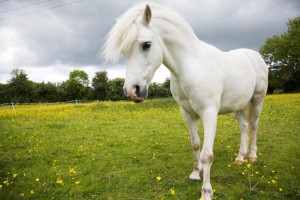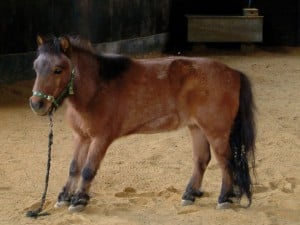What is laminitis?
Laminitis is a painful swelling of the laminae, the delicate soft tissues that hold the pedal bone in place within the hoof. If these tissues are compromised, the pedal bone is not supported correctly within the foot, which may lead to it sinking or rotating. The consequences of laminitis can be very serious.

The horse’s digestive system has naturally developed as a trickle feeder to eat high forage diets, and to eat little and often. The digestive system is therefore not suited to breaking down large ‘meals’ rich in starch and sugars. If large amounts of food are consumed, the restricted amount of space in the stomach, (which is only the size of a rugby ball) cannot contain all of the feed. A one-way valve stops anything going back up the oesophagus, so as the stomach gets full, food is pushed further down the digestive system into the small intestine. In cases where excessive amounts of food are eaten it can also be propelled through the small intestine too rapidly - so enzymes and acids from the stomach and the enzymes secreted by the small intestine do not have chance to work to their full efficacy, and starch and fructans can reach the large intestine undigested.
The large intestine (or hind gut) is designed to digest fibre, with the help of large populations of good bacteria present there, which ferment fibre to break it down. However, if starch or fructans are present, the bacteria prefer these to the fibre; and more readily attack them. The fermentation of starch and fructans results in production of lactic acid. Different bacteria thrive, and their populations grow, which changes the environment in the gut, killing vast numbers of the helpful bacteria. The dead bacteria release ‘endotoxins’ that enter the blood supply through lesions in the gut wall, also caused by acidic damage from the lactic acid. The endotoxins damage and inflame blood vessels. When the blood vessels in the hoof are affected they become swollen and very painful. The blood supply to the laminae is limited, so not enough oxygen and nutrients reach the cells, and the cells may die, in turn releasing more harmful endotoxins into the bloodstream.
Laminitis can affect all four of the feet, but often the front legs are more severely affected than the hind. If this is the case, a typical laminitic stance may be shown - front legs stretched out, with their weight on the heels. In some cases horses will lie down to take the weight off their feet. In others the horse will present as lame, especially on hard surfaces. Classic signs of laminitis include the sole of the hoof being sensitive to pressure, the digital pulse rate will be fast and strong, and the wall of the hoof and the coronary band may be unusually warm. In chronic cases, where the inflammation in the hoof has been ongoing, the horse will often have restricted movement, sign of ‘rings’ on the surface of affected hooves, and hooves will become slipper shaped. Contrary to popular belief, both horses and ponies are at risk of Laminitis, however it is most prevalent in Native ponies.

What causes Laminitis?
Laminitis can triggered by various factors and experts have still not put their finger on a definitive cause. However, it is most likely to be caused by excessive intake of starch or fructans (the sugars found in grass and certain other vegetation). This causes problems in the hind gut. Excessive grass or cereal consumption is the usual culprit, and is especially a problem during the spring when grass is lush and fast growing. Horses which are overweight, suffering from Insulin resistance, PPID (Cushings Disease) or Equine Metabolic Syndrome are at a much greater risk of laminitis. Excessive work on roads or jumping on hard ground can cause trauma to the laminae, causing excessive cortisol release, which can alter blood flow to the feet.
Laminitis Feeding Checklist:
- Feed little and often
Even a fat pony should never be starved: aim to feed forage at a rate of 1.5% of the horse’s bodyweight, and ideally split this so the horse is fed every 4-5 hours.
- Feed a high fibre, low sugar and starch diet
Avoid cereals, mixes, and sugary treats.
- Look for Laminitis Society Approved logos on feed labels if you are unsure what to feed
Foods suitable for laminitic equines include unmolassed sugar beet, alfalfa, straw chaff and oils.
- Limit grass intake!
Use a grazing muzzle, strip graze or use non-grass turnout to reduce grass intake, especially when grass is frosty, and during spring and autumn flushes.
- Forage first
Build your diet around forage. To ensure that your forage source is low in sugar and starch, get a forage analysis performed, or alternatively soak or steam hay to reduce sugar levels. Late cut hay also tends to be low in sugar and starch.
- Balance the diet of laminitic prone diets
Use a supplement or balancer to provide essential vitamins and minerals and amino acids to fully balance a forage based or restricted diet. Addition of beneficial herbs can also encourages antioxidant activity, good circulation and all round health which may be beneficial.
- Add pre and probiotics to the feed
By feeding pre and probiotics we can help to encourage the growth of good bacteria in the gut, and create a hostile environment for the bad bacteria, helping to keep your horse or pony healthy.
Olivia Colton MSc
Nutritional and Technical Coordinator, Feedmark

